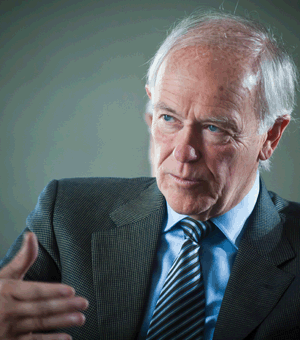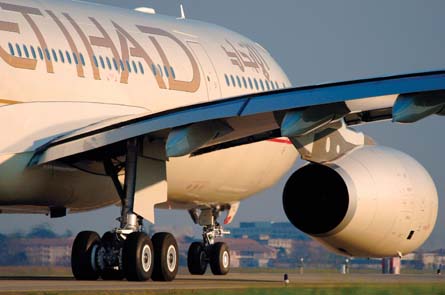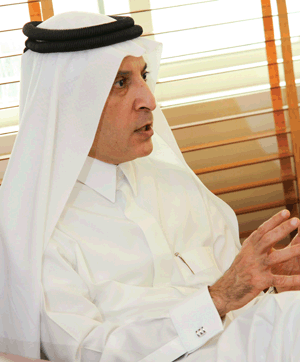 |
| © Emirates Emirates profits jumped by 43% in its latest financial year |
For two of the Gulf's three global network carriers, 2011 is turning out to be a landmark year in both their relatively short existences. For the region's more well-established player, it has been one of consolidation and growth, rewarded by some impressive financial results. In the meantime, the three rivals have had to ride out the political turmoil across local markets and deal with growing aggression from the legacy network carriers, which are becoming more vocal about what they perceive as an uneven playing field.
But they all remain committed to their high growth trajectories, despite uncertainties about the outlook for global demand and a stubbornly high fuel price. Few would bet against any or all of these airlines making the headlines at this month's Dubai air show, as they jostle for position and prepare for the next stage of their network development.
This year has been special for Qatar Airways, as it reached its first century in terms of destination count and fleet size, just 17 years after launch. The Doha-based airline also acquired its first shareholding in a foreign carrier - Cargolux - and is already making its presence felt there. Similarly, 2011 will mark an important milestone for Abu Dhabi-based Etihad Airways, which has seen strong financial growth, and is on course for its first break-even. Profitability is the next target and is confidently predicted for next year. It has also been busy constructing some sophisticated codeshare relationships, which are already delivering straight to its bottom line.
Meanwhile, Dubai's Emirates - which marked its 25th anniversary last year - enjoyed a 43% rise in group net profit to UAE dirham (Dh) 5.9 billion ($1.6 billion) on sales that were up more than a quarter to Dh57.4 billion for its 2010-11 fiscal year. The airline arm contributed the bulk of the profit, to the tune of Dh5.4 billion.
 |
| © Billypix Clark: Transpacific services are the only piece of the jigsaw missing |
But Emirates Airline president Tim Clark is not resting on his laurels, as he pursues the master plan to globalise the airline's network. "This isn't a token presence in a particular city via multiple intermediate points," he says. "This is a robust presence in the points that we serve on a minimum of a daily basis and eventually two or three times a day."
Clark says that "the only piece of the jigsaw that's missing" is the introduction of trans-Pacific services. "We're just getting into the start positions - we have the West Coast of the USA; we have Chinese points; we have Asian points; we have Australasian points. So the Pacific is encircled, and the next stage is to link the dots - we have the rights."
As he stays on the growth throttle, Clark is also turning the screw on costs, because "the stubbornness of the oil price has raised concerns about the bottom line", he says. "We're all a little bit concerned about what is going on in the global economy and the volatility. And when there is volatility it has effect on demand."
Emirates serves about 114 destinations across every continent and has a passenger fleet of 150 aircraft. Last year it carried 31.4 million passengers, a rise of more than 14.5%.
Clark says that the airline's "total focus" on growth may have allowed some costs to have increased at a greater pace. "Behind the scenes we're going to have to be a bit more thrifty. We've got to dig deep and go into structural costs to see where we can start pulling out 5-8%."
Etihad, which is a relative youngster and still two years away from its tenth birthday, has enjoyed a solid year, as chief executive James Hogan steers the airline on his multi-year plan to profitability.
"We've met the cost targets we set internally. We've seen great improvement in seat factor and we've seen the benefit of our O & D [origin and destination] system kicking in," he says. "Our codeshare relationships have also been very important to us - especially the alliance with Virgin Australia on the 'Kangaroo route'."
The airline's third-quarter revenue exceeded $1 billion for the first time this year, recording a 39% year-on-year increase in the three months to September to $1.1 billion.
"We're forecasting revenues close to $4 billion for the full year [compared with $2.9 million in 2010]," says Hogan, who is confident the airline will achieve its objective of breaking even in 2011.
Hogan says that if the airline can keep moving forward, "we believe we're in good shape and I'm confident we can move the airline into profit next year". This, he says, is in line with the business plan he drew up for Etihad when he joined the airline.
Etihad carried more than seven million passengers last year. It currently serves about 70 destinations from its Abu Dhabi hub, and has a growing presence in almost every major market. "We've announced we're going to Dusseldorf, Chengdu and Shanghai, we'll see more expansion in Africa and over the next couple of years more services into Asia, the Americas, and flights to India's secondary airports," says Hogan. The one continent where Etihad is yet to tread - but its rivals are already present - is South America. "We intend to go there in 2015," he says.
 |
| © Etihad Airways Etihad operates 58 passenger aircraft and five freighters, and has nearly 100 orders |
Qatar Airways, which was launched in 1994 and a decade ago had just a dozen aircraft, recently took delivery of its 100th unit - a Boeing 777-200LR. It also added its 100th destination in spring and has continued to add more points to its network this year.
And this high-growth expansion is set to continue in the near term, warns chief executive Akbar Al Baker. "We will continue the aggressive growth until 2013 - that's over 25% and the addition of 10-12 destinations annually," he says. "From 2013 we'll maybe add two or three destinations a year and grow at around 10% annually."
The airline carried 16 million passengers in 2010-11, and passenger growth is consistently running well into double digits. As Qatar expands, Al Baker is confident that - while he won't be a catch his market-leading rival Emirates from a traffic perspective - he'll be able to get on terms financially before this decade is out. "At a certain time in the current decade our revenue figures and our fleet numbers will be similar to Emirates, although our ASKs [available seat kilometres] will be lower as we operate shorter routes and smaller aircraft," he adds. This year the airline began to broaden its product portfolio through the acquisition of a 35% stake in European long-haul freight carrier Cargolux. Qatar Airways has a strategic aim to become a major freight player by 2015, which Al Baker says is seen as a way to "fuel our growth plans".
He adds that the deal took some six years to conclude, and sees it as a strong move for both airlines. "There will be so many synergies that benefit us both, and it will make Luxembourg a stronger [cargo] hub," he says.
It was probably no coincidence that, with Qatar Airways' reputation for hard bargaining, shortly after the stake acquisition was concluded Cargolux found itself involved in a brief but high-profile contractual dispute surrounding its first 747-8F delivery.
Relentless fleet expansion using the latest toys from Seattle and Toulouse are central to all three airlines' strategies. Between them they have over 440 Airbus and Boeing aircraft on order and are hugely influential in the design and development of new equipment being developed by both manufacturers.
Emirates's all-widebody fleet comprises 45 A330/A340s, 15 A380s and 90 777s, as well as nine freighters - six 747-400Fs and three 777Fs. Firm orders for just over 200 more widebodies are held, including 70 A350 XWBs, 42 777-300ERs and an eye-watering 75 A380s, as well as 20 freighters - 15 747-8Fs and five 777Fs. But a significant portion of these orders will be used for replacement, as its oldest passenger aircraft have now been in service for between 10 and 15 years, and these are about to start being retired. The passenger fleet will grow to about 185 aircraft by March 2013.
"By September 2013 we'll have 44 A380s and have taken most of our 101 777-300ERs," says Clark. "We're gradually phasing out about 70 aircraft - A330s, A340-300s and 777 Classics. Most will have gone by about 2015 or 2016, although one or two will be retained longer."
Etihad now operates a fleet of 58 passenger aircraft and five freighters. It is gradually expanding with additional Airbus A330 and Boeing 777 aircraft. In the past 12 months it has added six aircraft, and next year seven passenger aircraft will join the fleet - three Airbus A320s and four 777-300ERs.
Etihad has orders for almost 100 aircraft, the bulk of which are widebodies, although its backlog does include 20 A320 narrowbodies. The next phase of Etihad's fleet development starts in 2014, when the first A380s and 787-9s are due to arrive, with A350s set to follow from 2017. Qatar Airways is a regular shopper at the air shows, and is expected to add to its existing order backlog of about 140 aircraft with deal announcements at Dubai. These could include A320neos, and possibly A380s and Bombardier CSeries - all of which are announcements that had originally been expected at the Paris air show in June.
"We'll continue to receive a new aeroplane on average every 15-16 days," says Al Baker, however from 2013 this will switch from being primarily expansion-driven to also cover retirements. Its current fleet of 100 aircraft includes a mix of Airbus single-aisles, A330/A340s, and 777s. Some of the existing A320s and A330s will start to be retired from 2012, "depending on how the deliveries of our new aircraft go", he says. Al Baker is likely referring to the much-delayed introduction of his Boeing 787s, which were originally due to be delivered from early 2010 but should now begin to arrive in the first half of 2012. Al Baker sees the 787-8 as "an excellent route development tool", and Qatar will use the twinjet initially to develop new European points with widebody capacity that could not be economically sustained with its existing widebody types.
"The 787-8 has been acquired primarily as an A330-200 replacement, but may also replace the A321 on some denser, short-haul routes," he says.
Initial operations next year will see the type deployed to Qatar's intra-Gulf services to aid the crew training effort, and the fleet will then migrate progressively on to longer routes, serving points in Europe and Asia.
 |
| © Qatar Airways Qatar has taken delivery of its 100th unit |
Qatar's A330 fleet is earmarked for freighter conversion - subject to Airbus agreeing a modification deal - and these aircraft will be used both by Qatar Airways' cargo arm and for lease to third parties by the group's leasing division.
Qatar should begin receive two new Airbus widebody types in 2013 - the first of five A380s and 80 A350s. However, with the airline being launch customer for the latter, Al Baker is resigned to the likelihood that the planned service entry of late 2013 will be missed.
Although the 787 and A350 families have some overlap in size and performance, the two types will have quite different roles in the Qatar fleet, says Al Baker. "At Qatar Airways, the 787-8 is principally a frequency development tool, whereas the A350 is a capacity development tool."
It is no surprise that all three Gulf carriers are launch customers for Airbus's largest A350 variant, the -1000. Two of them - Emirates and Qatar Airways, who together account for 40 of the variant's 75 orders - are less than impressed with the revamp Airbus announced at Paris, along with a two-year delay to service entry. The changes centre on a modified, more powerful variant of the Rolls-Royce Trent XWB engine, along with increased weights.
Qatar has 20 -1000s on order, though Al Baker believes that Airbus has not gone far enough to improve the 350-seater's competitiveness over the 777-300ER - and has threatened to cancel his contract. "Why should I go for a new aeroplane while I already have one that has more revenue generation and just a little less range?" he told Flight International at the Paris air show in June. "Airbus is not listening to us - I don't think they've achieved anything with this investment."
Al Baker's views align with those of Emirates' Clark, who is unhappy that the revisions were implemented without any dialogue: "If they had talked to me, I would have said: '[The improvement is] not good enough'," he says. "On paper, the old -1000 was hugely economical - it was a 777-300 classic replacement. That's why I talked about converting my -900 orders."
But that possibility has dimmed with the changes, and Airbus's US rival could hold the answer. "There's a lot of work going on [at Boeing on the new 777], and we're involved in it," says Clark, who says that Emirates could be a launch customer if the specification fits its needs.
 |
| © Billypix Akbar Al Baker: 'regional issues' dented Qatar Airways' profitability |
While the Arab Spring across North Africa and the Middle East had some effects on the three airlines' fortunes, it has also severely hampered the short-term prospects for the Middle East's once great network carrier Gulf Air, whose Bahrain home base was at the centre of the political turmoil.
This could not have come at a worse time for the airline, as it was beginning to reorganise its network and restructure its orders as part of a strategic repositioning under experienced chief executive Samer Majali in favour of smaller-capacity aircraft. Although much of the Gulf Air revamp is yet to be formally confirmed, due to political sensitivities, there have been hints as to its progress.
Earlier this year it cancelled eight of the 16 787s it had on order. During the Paris air show the airline selected International Aero Engines powerplants for a batch of six A321s, to be delivered next year. It is also believed to be acquiring the CSeries 110- to 140-seater, although the deal has not been formally confirmed.
Al Baker acknowledges that the Arab "regional issues", as well as the rising oil price, dented Qatar Airways' profitability in 2010-11. Hogan says that the Arab Spring, along with the Japanese earthquake, affected its first half figures, but this prompted Etihad to be "very bullish and aggressive on the Q3 and Q4", and to focus much harder on costs.
Clark says Emirates "dealt" with the problems caused by the region's political unrest and is now optimistic for the future. "I'm a great opportunist and a great believer that the change will deliver good," he says.
Since the Ben Ali regime was overthrown in Tunisia, Emirates has enjoyed a boom in business from the country: "It was extraordinary: as soon as that government went, our flights filled up," Clark adds. He says that all the "quality exiles" that had previously left the country in the Ben Ali era have been invited back.
These countries will all need help and support to recover, says Clark, "but there are going to be great opportunities there, definitely", he adds.
- Follow the latest news, views and videos from the Dubai airshow on our dedicated site
Source: Flight International



















